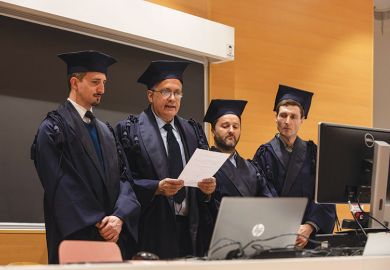While we had talked about embracing technology-enhanced learning at the Singapore Institute of Technology, it was a different story when all classes of more than 50 students had to be converted to e-learning in the middle of the semester. At the back of our minds, we were also ready for full e-learning to take place if the situation worsened, but the reality was different.
The panic occurred five weeks ago and thankfully the online learning experience has generally been positive.
While there was no necessity for university closures in Singapore, we fully implemented our e-learning platforms across the entire university for all large classes. We were able to reduce contact between students and were ready to escalate measures if needed.
While some faculty members already had competencies in online or remote teaching in four areas – live streaming, pre-recorded teaching sessions, facilitating discussions in a digital platform and providing assessment and receiving feedback – much background preparation still had to be done to get academic staff, students and infrastructure ready for lessons to transition seamlessly into online learning.
Let me share what helped.
A consistent, whole university approach
While flexibility was needed to ensure different learning outcomes could be achieved in different programmes, consistency across the university was important in this time of crisis. Across SIT, all classes with more than 50 students switched to online learning. Any classes that needed to remain face-to-face, such as laboratory sessions, were broken into smaller groups. It was not left to individual departments to decide how to implement a consistent approach of social distancing across the university.
Licences or access to technology such as Zoom, Respondus and Microsoft Teams was made available to all teaching staff and students. It allowed lecturers to choose what worked best for them and their students. It also allowed training and guides to be provided based on the key tools that were available. The key tools provided some consistency so that students were neither confused nor rushed into learning different tools.
Ensuring learning outcomes were uncompromised
Flexibility while ensuring accountability was important. As certain assessments could no longer take place as planned, alternative methods were needed to assess the same learning outcomes. As we ride out the crisis, the degree programme must be recognised and therefore all learning outcomes must still be achieved and demonstrated despite contingency measures that were in place. A policy was written up to introduce flexibility with faster approval routes for changes that were needed. This ensured that all assessment changes were reasonable and fair.
It was emphasised that online platforms were to be viewed as learning environments, like classrooms and lecture theatres, that enabled effective learning to take place. Despite the rush, it remained important to engage learners. While it was possible for lecturers to just upload previous years’ lecture recordings, many academic staff chose to conduct live streaming classes and attempted to use polls and quizzes to engage learners. Many academic staff were doing live streaming for the first time, but they were willing to take the risks and, in return, received compliments for the positive learning outcomes.
Remaining student-centric
Because there were students who had contact with Covid-19 patients, it was important to consider the ones who could not come to campus. We communicated our stance that students who were on a leave of absence or under quarantine orders were to be supported with alternative learning plans.
Instead of expecting them to catch up with their classmates on what they had missed, teaching staff made arrangements to ensure they could receive the learning content and have questions answered. It was important to ensure that they were not missing out on learning. Having technology on hand to allow them to participate in discussions whenever possible helped.
While the assumption is that most students have a laptop to do e-learning, there is always a small number who don’t. Arrangements were made for students to borrow laptops. This ensured that no one was left behind in the transition from face-to-face to e-learning.
Having clear, frequent communication
It was key to understand concerns at different points in time. A university-wide survey was done just before e-learning replaced all large classes. Students’ feedback was consolidated and communicated to all teaching staff. Common concerns included effectiveness of online lectures, changes in assessment, and self-discipline when learning online.
We did pulse checking through student management committees two weeks after the online replacement of all large classes. This enabled further tweaks to improve the experience. Online meetings were conducted with programme directors and teaching staff to share experiences and rectify common mistakes that were made.
More communication channels were important, ensuring that despite not physically seeing each other, concerns and experiences were shared. The feeling that “we are in this together”, or “if I make a mistake in the online learning platform, I am not the only one”, helped to support everyone in the journey.
It was also important to check in with students with special needs, as well as those who were academically weak, to see if they were transitioning smoothly into a different mode of learning.
Making training available in all shapes and sizes
We rushed into creating many types of training for lecturers to provide online learning, including face-to-face workshops, walk-in consultations, online training and self-help guides. The topics covered how to create narrated slides, how to run effective live streaming classes, how to design alternative assessments, and the use of online proctoring tools for assessments.
Apart from teaching staff who needed training, students were also provided with guides to use the tools, and on getting themselves ready to learn in an online environment. Academic advisers also spent time talking to students about topics such as time management, managing procrastination and recognising that the online learning environment could be distracting for some students.
There were, of course, some mistakes that could have been avoided
Hybrid models – where large classes are stopped but smaller face-to-face classes continue – can be hard. If any university were to implement this, one important point to remember is timetabling. If students are expected to participate in live streaming online environments, they need quiet locations to do so. Unless the university has adequate quiet spaces, it can be tricky for students to rush from attending an online class at home to coming in physically for laboratory classes.
If individual lecturers are to run hybrid classes, it takes extra skills and effort to ensure that whatever is communicated in the physical environment is clearly articulated to those at home. Unless the staff member has a device, such as a portable microphone, that allows them to walk around and still project their voices through the laptop, students logged in online can struggle to hear what is being said in the classroom.
Presetting certain features in online learning tools can help prevent some nightmares. Zoom, for example, has features that can be preset, such as auto-mute upon entry or auto-record. Common mistakes reported include students coming into live streaming sessions with private chats streamed for all to hear or running a session and forgetting to record it.
It’s not perfect, but it’s going well
It was unfortunate that one of our students contracted Covid-19 and that a cohort of students had to stop coming into university for two weeks. Nonetheless, they continued learning, and so did the infected student, who live streamed from the hospital when he was well enough.
As for the other students and teaching staff, with social distancing measures in place we are also discovering the joys of online teaching and learning, and improving pain points along the way.
Staying united and learning together through times of crisis has been our biggest lesson from this experience.
May Lim is an associate professor at the Singapore Institute of Technology and director of the Centre for Learning Environment and Assessment Development.
Register to continue
Why register?
- Registration is free and only takes a moment
- Once registered, you can read 3 articles a month
- Sign up for our newsletter
Subscribe
Or subscribe for unlimited access to:
- Unlimited access to news, views, insights & reviews
- Digital editions
- Digital access to THE’s university and college rankings analysis
Already registered or a current subscriber?








